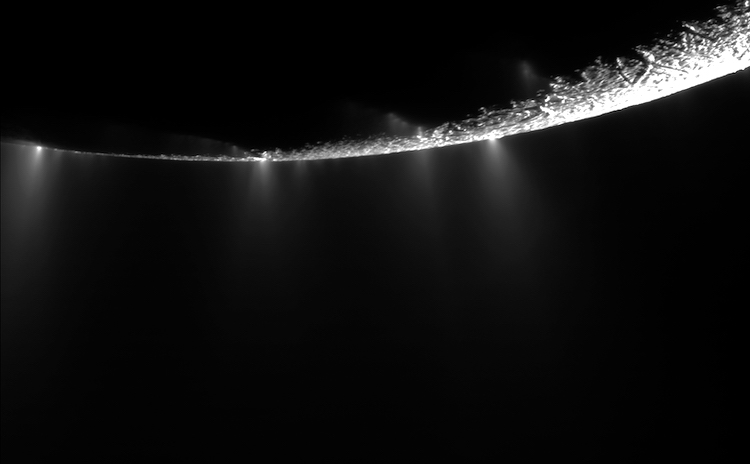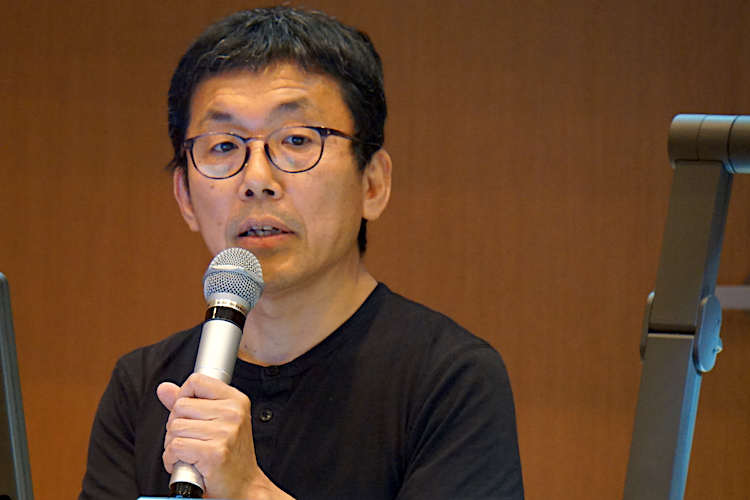Japanese Earthlings probe “Proto-Alien” synthesis
Published 18 June 2019 by Cherise Fong
Gathered for a day at Tama Art University in Tokyo, seven professors and researchers in arts and sciences shared their perspectives on life, from biosemiotics to extraterrestrial agents.
From our correspondent in Tokyo
What is life? What makes up a human, an octopus, a crow, an iguana, a fern, an ant, a jellyfish, a microbe… knowing that all life on Earth originated from the same primordial soup? And what if we were all born from stardust? What other forms of life exist beyond our own planet?
Two professors from Japanese universities, Akihiro Kubota (whose artistic satellite Artsat was awarded at Ars Electronica in 2015) and Juan M. Castro, invited a handful of researchers in astrobiology, biochemistry, speculative biology, biosemiotics… to discuss these questions and the issues that surround them. On June 7, 2019, in an auditorium on Tama Art University’s Hachioji campus west of Tokyo, about a hundred students and visitors came to listen to these experts during a symposium entitled “Matter(s) in Motion”.

Akihiko Yamagishi, professor at the Tokyo University of Pharmacy and Life Sciences, reminds us that all living beings are composed primarily of polymers of amino acids in liquid, a sort of protein soup with RNA that forms a genetic system. He also points out that such organic compounds have been found in the molecular clouds of certain comets, asteroids, meteorites and other cosmic dust.
The Tanpopo mission instigated by Yamagishi is an investigation of the panspermia hypothesis, which posits that life on Earth germinated from extraterrestrial microorganisms. From May 2015 to February 2018, the Japanese experiment module installed on the International Space Station, which orbits the Earth every 90 minutes at an altitude of 400km, captured samples of micrometeoroids (weighing less than 1 gram). The objective of the Tanpopo mission is to estimate the density of microorganisms situated at this altitude and to determine the resilience of Earth-based microbes exposed to outer space. Some of them, says Yamagishi, can survive near the surface of Mars.

Chemist Taro Toyota, associate professor at the University of Tokyo, wears a bright yellow t-shirt bearing the Japanese words for “artificial cell life”. He is particularly interested in the lipids present in the primordial soup of life. He and his colleagues are doing experiments with oil in water, observing the transformation and self-propelled movement of the resulting soft micro-objects. These artificial models of chemical cells have been recognized as plausible prebiotic structures from which life on Earth could have emerged.
Yasuhito Sekine, professor at the Earth-Life Science Institute of Tokyo Institute of Technology, brings out the poetry in celestial bodies, rocky, icy and gaseous. Inspired by American astrobiologist Carl Sagan’s quote from the 1970s “Extraordinary claims require extraordinary evidence”, he continues to search for extraordinary life forms in outer space: on Mars, where organic matter has been found in the sediment of ancient lakes; on Jupiter’s moon Europa, where the presence of salt from an underground sea has been confirmed, as seen in the red stripes of its icy surface; on Saturn’s moon Enceladus, where water from the underground ocean erupts through the ice into geysers; on Saturn’s biggest moon Titan, whose thick atmosphere of gases contains lakes of liquid methane that could potentially harbor a form of life.


Life as we know it, says Sekine, requires three things: liquid, energy and organic compounds. According to these criteria, the habitable zone of our Solar System already includes some 20 celestial bodies. And let’s not forget that beyond our own Milky Way there are billions of other galaxies in the universe…
Bio art and carbophilia
To give some artistic and cultural context to all this scientific research, Ingeborg Reichie, professor at the University of Applied Arts Vienna, presented a short history of speculative biology through iconic artworks that comment on the relationship between the arts and the medical sciences: from 19th century German pathologist Rudolf Virchow’s “living” sculptures created from his own cell tissue, to Mary Maggic’s latest bio-hacking experiments (such as Open Source Estrogen in 2016). More than an esthetic vision, says Reichie, bio art offers a critical reflection on the changing context in which life can exist.
Jens Hauser, researcher at the University of Copenhagen, notes a gradual transition in artworks involving artificial life—from a tendency which he calls “carbophobic” (e.g. lifelike appearance or behavior, robotics, Leonel Moura: “The main point is to generate life as an artistic expression (but not life as it is, rather life as it could be)” toward more “carbophilic” practices (e.g. synthetic biology, wetware, Eduardo Kac: “Bio art uses the properties of life and its materials, changes organisms within their own species, or invents life with new characteristics”).

“If ‘life’ as a concept is above all a pattern transposable across media,” says Hauser, “extreme ecologies of ocean life, phytoplankton, extremophile bacteria and astrobiology need to be scrutinized for their innate technical capacities of microorganisms when ‘nature’ itself engineers and synthesizes.”
Furthermore, according to the biosemiotician, bio art is more recently taking an interest in epistemology: “Beyond the mere use of BioBricks, such art also investigates and addresses fields such as origins of life, microbial and protocell research.”
And though we may be living in the Anthropocene era, an anthropocentric vision limits our research as much as our imagination. “Wetware art creatively and critically investigates the anthropocentric mindset in engineered moist artificial life and the responsibility that arises with it,” Hauser insists. “Artistic practices that materially involve biotechnologies aim at increasing awareness for the invisibility of the microscopic and the incomprehensibility of the macroscopic. They question, philosophically and politically, the human scale as crucial reference point.”
Proto-Alien
What if we could synthesize other forms of extraterrestrial life here on Earth? Because if alien life did not exist, we would have to invent it.
Juan M. Castro, associate professor at the Institute of Advanced Media Arts and Sciences, presented the Proto-Alien project, which he is researching in collaboration with professors Kubota and Sekine. Their objective, both scientific and artistic, is to create protocells at the boundary between the living and the non-living using non-terrestrial materials and to cultivate them in liquids other than water.
“Our aim,” Castro explains, “is to use extraterrestrial matter to grow soft, active and intelligent agents: autonomous ‘others’ that thrive and avoid equilibrium in extraterrestrial environments: a new type of alien agency, yet unknown to humankind.”

Returning to discussions on life in the largest sense, Akihiro Kubota emphasizes the importance of eliminating human assumptions and exploring all the sweet spots where scientific research overlaps artistic imagination (which speculative science-fiction has been doing for centuries…). Even on Earth, he reminds us, there exist shadow biospheres in the depths of the ocean and deep underground, referencing David Toomey’s book Weird Life, which describes several forms of life on (and under) Earth that are radically different from us.
Speaking of extremophile chemolithoautotrophs, microbiologist Karen Lloyd (unfortunately not present at the symposium) from the University of Tennessee gave two fascinating Ted talks in 2018 and 2019 about undersea and underground bacteria that live without light or oxygen, that breathe, eat and excrete rocks… and that refuse to grow in a Petri dish.
Why? Because these microorganisms subsist on approximately 1 zeptowatt (10 to the power of -21 watts) of energy, as opposed to the 100W necessary to animate a human being, which means that their metabolism is measured in thousands if not millions of years—in other words, at a slowness that is imperceptible on a human scale of time. Microbiology, geology or pseudo-astrobiology? The DNA of the most obscure microbes indicates that we all come from the same primordial soup…
More information on the symposium “Matter(s) in Motion”
